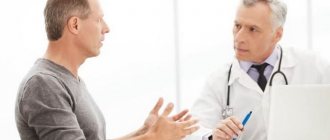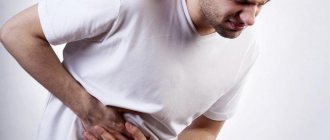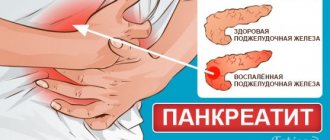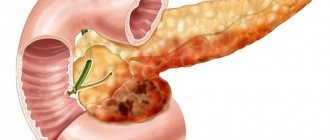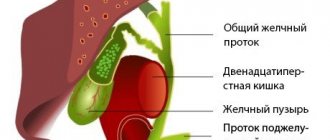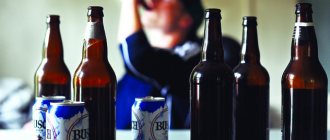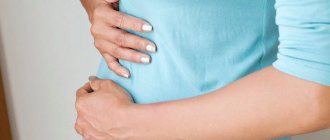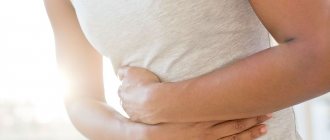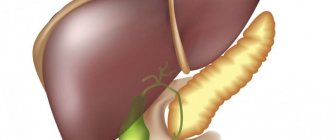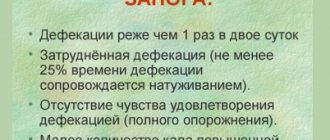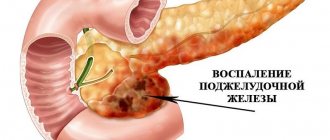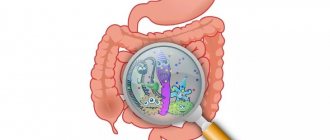Pancreatitis and cholecystitis, affecting the pancreas and gallbladder, respectively, often go hand in hand due to the similarity of symptoms and causes that provoked them. It is important to treat the joint disease of pancreatitis and cholecystitis at the same time - this is the success of therapy.
The pancreas produces pancreatic juice, which is secreted into the duodenum and helps digest food. The gallbladder, on the other hand, stores concentrated fluid produced by the liver. Cholecystitis develops against the background of inflammation of the gallbladder, but the main cause of pancreatitis is considered to be cholecystitis. The presence of both diseases at the same time is called cholecystopancreatitis.
Possible complications
Exacerbation of diseases occurs if proper treatment is not provided and the diet is not followed.
Inflammation of the digestive system is often accompanied by severe pain and interferes with eating. During an exacerbation, the patient is in a situation where his quality of life drops significantly. To alleviate the condition, he needs to spend more time in the air, move, and eat taking into account his problems. Possible complications from diseases are associated with a lack of enzymes entering the digestive system from the gland and bile reservoir. It can manifest itself as simple inflammation in them or a disorder in neighboring organs (stomach, liver), leading to diabetes mellitus. The acute course of the disease is possible due to alcohol poisoning, complications of cholelithiasis and requires urgent treatment.
Don't let the condition get worse. After all, an advanced disease leads to extensive necrosis of the pancreas and even death. It is possible to definitively cure chronic pancreatitis and cholecystitis only at an early stage. In other cases, maintain diseased organs in a state of remission, avoiding complications.
If we talk about ailments in general terms, a complication of pancreatitis and cholecystitis is considered to be the transition of these diseases to the chronic stage of their course. What provokes:
- Damage to organ tissue.
- The constant presence of infection in the body.
- Necrotic changes in tissues.
Chronic pancreatitis can develop into pancreatic necrosis - this disease is caused by the death of pancreatic cells. If necrotic changes occur in the tissues of the pancreas, the likelihood of death increases.
Diet
Without it, treatment of both acute and chronic cholecystitis or pancreatitis makes no sense. After all, any disease associated with improper functioning of the digestive tract is often caused by poor nutrition. Therefore, the patient must adhere to a diet that consists of following these rules:
- You need to eat little by little.
- It is forbidden to eat spicy, fatty and fried foods. A priori, in case of cholecystitis and pancreatitis, you should not eat canned food, sausages, or smoked meats. Alcohol, cocoa, and chocolate are strictly prohibited.
- It is healthy to eat fermented milk products, boiled vegetables, soups, cereals, steamed meat and fish.
- You can drink compotes and mineral water.
How to treat pancreatitis and cholecystitis with medications?
Acute or chronic pancreatitis and cholecystitis are treated comprehensively. Therapy includes a diet plan, medication, and physical therapy.
Therapeutic diet
Diet is the first and main therapeutic measure.
To cure cholecystitis and pancreatitis during an exacerbation, you need to follow 3 principles: cold, hunger and rest.
If in the acute course of the disease the patient is prescribed hunger, cold, rest, then in chronic pancreatitis patients are advised to eat properly:
- Eat small portions up to 7 times a day. Food should be warm.
- Avoid fatty foods, fried foods, smoked foods, hot spices, alcohol, chocolate, and soda.
- Steam dietary meat and chop before use.
- Include low-fat fermented milk products, vegetable stews, cereal soups and porridges in the menu.
- After eating, you should move for half an hour to increase the flow of bile and improve the digestion of food.
Dietary nutrition helps reduce the load on the gallbladder and pancreas, get rid of pain and heaviness in the abdomen.
List of drugs to treat cholecystitis and pancreatic insufficiency:
- Kontrikal, Antagozan - inhibitors of pancreatic enzymes. Drugs are prescribed in acute cases of the disease to suppress the secretory function of the gland.
- Methyluracil, Pentoxyl are anabolic agents indicated for improving metabolic processes in the body.
- Omeprazole, Cimetidine - to reduce gastric secretory function.
- Festal, Pancreatin are enzyme preparations necessary for the breakdown of food mass in the intestines into nutrients.
- Bactrim, Biseptol - these antibiotics for cholecystitis and pancreatitis are indicated to be taken to eliminate inflammation, especially if it was caused by an infection.
- Holosas, Cholenzym are choleretic agents that improve the outflow of bile from the bladder and its ducts.
- No-shpa, Papaverine, Motilium - relieve muscle spasms, relieve pain.
Folk remedies
Herbs for pancreatitis and cholecystitis improve the functions of the digestive system. Healing infusions for the treatment of gallstones and pancreas most often include chamomile, plantain, wormwood, immortelle, marigold, yarrow and other medicinal plants.
Effective folk remedies for pancreatitis and cholecystitis:
- Mix 1 tbsp. l. wormwood, immortelle flowers, yarrow and fennel seeds. Brew one tablespoon of raw material with 500 ml of boiling water, let it brew for 8 hours. Strain. Take 1 tbsp. l. during the day. The need and duration of treatment for an inflamed bladder must be agreed with a herbalist.
- Mix in equal parts crushed burdock and elecampane roots, marigolds, wormwood, St. John's wort, chamomile, string, sage and horsetail. Pour a large spoonful of the mixture into a thermos and pour 0.5 liters of boiling water. After 2 hours, strain. Drink the medicine for pancreatic insufficiency daily, 100 ml 30 minutes before meals.
It is impossible to completely cure chronic pancreatitis. Ultrasound heating of the abdomen helps to enhance the effect of drug treatment and accelerate the onset of remission. For inflammation of the gall bladder, electrophoresis is also prescribed (an easily digestible form of the drug penetrates the skin under the influence of direct current) to the liver area. This enhances the production of liver secretions and improves blood supply to the organ. About 10 sessions are required.
To facilitate the functioning of the digestive system, patients are prescribed to drink medicinal mineral waters of Borjomi, Essentuki, and sea water baths saturated with carbon dioxide. After the inflammation has been relieved, mud therapy and medicinal applications are prescribed for the area where the liver and pancreas are located.
Surgery on the gallbladder is prescribed if there are large calcifications in it that cannot be broken down by medications. Large stones can completely block the lumen of the excretory duct, which will negatively affect the functioning of the liver and pancreas. In such cases, the patient requires emergency surgery to remove them.
You cannot do without the help of a surgeon if pancreatitis is complicated by a purulent-necrotic process. In this case, the affected part of the gland is removed and drainage tubes are placed.
In 80% of clinical cases, cholecystitis and pancreatitis occur simultaneously, in 20% they cause exacerbation of each other. This is explained by the different anatomical structure of the digestive system in people.
The gallbladder and pancreas are close to each other, perform similar functions in the body, and have similar signs of inflammation. Therefore, self-diagnosis and self-medication is dangerous.
The combination of pathologies is given a name - cholecystopancreatitis.
Chronic cholecystitis and pancreatitis are long-term diseases of the digestive system. The first disease is pathological changes in the walls of the gallbladder, the second is a dysfunction of the pancreas. Both organs become inflamed simultaneously due to blockage of the common excretory duct with calcifications, which enter there along with liver secretions.
Acute cholecystitis or pancreatitis requires surgical intervention. Therefore, you cannot put off visiting a doctor or calling an ambulance!
Only in 20% of cases pancreatitis is provoked by cholecystitis.
This happens if in a person the pancreatic duct does not unite with the common bile duct, but opens into the duodenum a couple of centimeters above it.
This increases the likelihood of pancreatic juice entering the bladder with subsequent irritation of its walls.
Pancreatitis and cholecystitis are caused by the same factors:
- formation of gallstones;
- excretory duct dyskinesia;
- infection of the gastrointestinal tract, urinary system;
- helminthic infestation in the liver and gall bladder;
- viral hepatitis;
- insufficient blood supply to the organ;
- poor nutrition;
- alcohol abuse;
- congenital anomalies (deformation, neoplasms);
- inactive lifestyle.
General symptoms of inflammation of the digestive system are nausea, vomiting, increased body temperature, increased sweating, and sharp pain in the abdominal area after eating. If a person does not have a medical education, then it will be difficult for him to determine which organ is inflamed.
A gastroenterologist knows how pancreatic insufficiency differs from cholecystitis. It is he who should be contacted for a diagnosis.
With pancreatitis of the pancreas, pain occurs in the left side, it can be girdling in nature. With cholecystitis, there is pain in the right side, radiating under the shoulder blade.
Due to cholecystopancreatitis, the required amount of pancreatic enzymes and liver secretions cease to flow into the intestines, where food processed by gastric juice should be digested and absorbed.
Duodenal digestion is disrupted (signs: flatulence, constant heaviness in the abdomen, diarrhea alternating with constipation).
Deadly complications of cholecystitis are gangrene and rupture of the gallbladder walls.
Establishing diagnosis
Basic methods for diagnosing inflammation of the digestive system:
- Ultrasound - to assess the condition of internal organs, identify calcifications in the bile and pancreatic ducts.
- Biochemical blood test - high levels of pancreatic enzymes confirm the acute form of pancreatitis.
- General blood and urine tests - an increased level of leukocytes confirms signs of inflammation.
- Scatological stool analysis allows you to assess the performance of the intestines.
Signs of inflammation of the bladder walls and pancreatic tissues are similar to the symptoms of other gastrointestinal diseases. To distinguish them, the patient is prescribed a differential diagnosis.
In this article, we will dot the i's in the problem of double diseases of the gastrointestinal tract, namely simultaneous diagnoses of cholecystitis and pancreatitis. We focus on how to treat cholecystitis and pancreatitis: from drug therapy to surgical intervention.
Terminology
Cholecystitis is an acute or chronic inflammation of the gallbladder, in which the bile ducts are blocked, which leads to systemic disruptions in the gastrointestinal tract, namely, the outflow of bile is impeded.
The gallbladder is an organ of the digestive system, which is anatomically part of the liver and is similar to a chicken egg. The main task of this organ is to accumulate and remove bile, which is necessary for the absorption of fats and improving the “transport” of food through the intestines.
The liver produces bile. During the day, the body of a healthy person produces from half a liter to two liters of bile. In order for bile to enter the intestines, it must pass through the bile ducts. The walls of the bile ducts contract and “supply” bile to the gastrointestinal tract; if they cannot do this, various diseases arise, for example, cholecystitis
The pancreas is an integral part of the digestive system. In humans, it is located behind the stomach. Let us note that the pancreas is extremely important for the functioning of our body, since without this gland the entire gastrointestinal tract ceases to function, which leads to death.
Cholecystitis
The most striking symptoms of gallbladder inflammation are:
- sharp pain in the right side just below the ribs. The pain may be short-term
- constant heaviness in the same area
- temperature increase
- bitterness in the mouth
- vomit bile
- bloating
- persistent constipation or diarrhea
- loss of appetite
- food allergy
Pancreatitis
Symptoms of this disease may include the following disturbances in the functioning of the body:
- acute girdle pain in the stomach with a slight shift to the left or exactly in the middle
- nausea
- vomiting, after which it does not get better
- attacks of tachycardia
- feces with remnants of unprocessed food
- bloating
- increased body temperature and/or changes in blood pressure
- change in skin color on the face. It takes on an earthy hue
- stool changes
Diagnostics
Choleretic fees
To stop the inflammatory process that has affected the pancreas, most gastroenterologists in their prescriptions give preference to plant-based choleretic agents. These drugs are herbal mixtures of herbs that can effectively stimulate the production of bile. But despite the safety of the herbal components that make up these products, they should not be taken without a doctor’s recommendation.
A choleretic preparation for acute pancreatitis or relapse of chronic pathology is prescribed depending on what disease provoked the appearance of negative symptoms and what signs of the disease are most pronounced. In pharmacies, such herbal remedies are presented in three versions. Their composition, the effect they have on the body, as well as the recommended brewing method are described in the table.
Pancreatitis and cholecystitis: treatment of a joint disease
The gallbladder and pancreas (PG) are interconnected. The organs actively participate in digestion, secreting, respectively, bile and pancreatic juice, without which the breakdown and absorption of proteins, fats, and carbohydrates is impossible. Unlike the pancreas, the bile duct itself does not produce its own secretion, but is only a reservoir for its accumulation and release at the right time. The liver produces bile.
Inflammation in one organ often causes inflammation in another, due to:
- anatomically;
- connection of ducts when entering the small intestine;
- the possibility of throwing the secretion of one organ into another in the presence of predisposing factors.
The structure of the excretory ducts of the bile and pancreas
Combined inflammation of the gallbladder and pancreas in medicine is called cholecystopancreatitis. In its chronic course, it leads to impaired organ motility, insufficient production of enzymes and bile into the duodenum, which complicates the digestion of food and the supply of nutritional components. Symptoms of this pathology manifest themselves in the form of nausea, a feeling of heaviness in the right hypochondrium after eating, and periodic dyspeptic disorders.
Treatment of cholecystitis and pancreatitis with medications is prescribed only by a doctor and is carried out comprehensively, taking into account the form, severity, and phase of the disease. With the right approach in the initial stages, it is often possible to completely restore the functions of the inflamed organs. However, untimely contact with a specialist and identification of pathology leads to the transition of the disease to a chronic form and the development of severe complications. Treatment of cholecystopancreatitis is long-term and requires taking measures to prevent exacerbations.
Treatment is prescribed by a doctor after assessing complaints, test results and examination.
Prescribed medications for pancreatitis and cholecystitis have the following effects:
- relieve pain;
- suppress the bacterial infection that caused the development of the disease;
- normalize the outflow of bile and pancreatic juice;
- eliminate congestion;
- compensate for the deficiency of produced enzymes;
- accelerate the regeneration of affected tissues.
Outside the acute stage, physiotherapeutic procedures (ultrasound, UHF, electrophoresis), spa treatment, alkaline mineral waters, decoctions, infusions of medicinal plants are used.
The functioning of the pancreas is closely related to the gallbladder. If the functions of one of the organs are impaired, the normal functioning of the other is impossible. Therefore, treatment of cholecystitis of various types and pancreatitis of any stage is carried out simultaneously, and these diseases are usually treated with medications and for a very long time.
medication treatment
Drug treatment of pancreatitis, as well as cholecystitis, is the main means of getting rid of them. It consists of taking medications of different spectrum of action, which are determined by the doctor. Usually they prescribe drugs that will be equally useful for the restoration of both organs.
Today, any medical research method shows that the cause of cholecystitis is infection. Therefore, in its treatment, the third generation of cephalosporins (Ceftibuten, Cefotaxime, Ceftibuten) is used.
Antibiotics
antibiotics
Antibacterial therapy is indicated if there is stagnation of bile, the walls of the gallbladder and pancreas are inflamed. The drug is prescribed in the form of tablets or intramuscular injections. Penicillins are effective in counteracting microbes. To get rid of staphylococci, gram-negative microbes on which they have no effect, Gentamicin injections are used. Patients are often prescribed Amoxicillin, Clarithromycin, and Ampiox.
The antibiotic "Bactrim" effectively suppresses infections. The suspension is taken twice a day before meals with measuring spoons (1 each if the phase of the disease is chronic, 6 – with an exacerbation). The course of treatment is at least 5 days. Another antibiotic, Biseptol, is considered a safe but powerful remedy. Prescribed for 4 days with a daily dose of 480 mg 2 times or once 960 mg (chronic course), 3 times during exacerbation.
Chronic cholecystitis with pancreatitis can be treated with choleretic drugs at any stage of the disease. Since bile from the bladder penetrates the pancreas, provoking its inflammation, reflux must be prevented. The problem is solved by using agents that cause the production of bile and prevent it from stagnating.
Choleretic drugs for pancreatitis and cholecystitis are offered by pharmacists of several types, differing in their effect on liver function. The popular drug “Eglonil” is prescribed 3 times a day, 50 mg. The course of treatment is 4-6 weeks. Minimal intake during pregnancy is allowed.
The medicine in the form of a solution "Holosas" helps to cope with cholecystitis. Classic dosage - 2.5 ml (children), 5 ml (adults) 2-3 times a day 30 minutes before meals. For pregnant women - only on the initiative of a gastroenterologist.
Antispasmodics
The most famous drugs that reduce pain are: “No-shpa”, “Tramal”, “Ketanov”, “Spazmagol”. Motilium tablets are often used, prescribed to adults and children over 5 years of age (if they weigh over 20 kg). Take 10 mg 2-3 times a day half an hour before meals, the duration is determined by the doctor. The dose is adjusted if the patient has kidney or liver diseases.
Cholekinetics
These are drugs that help release stagnant bile from the bladder. For example, magnesium sulfide.
The load on both organs is well reduced by taking medications: Mezim, Pantprozol, Digestal, Festal, Creon. The inhibitor "Omeprazole", which is responsible for the production of pancreatic secretions, is prescribed in doses of 20 mg (or 40 mg for severe exacerbation) 1 time/day for a course of 1 month - 6 weeks. Take in the morning before or during meals.
cholekinetics
Pancreatin tablets are actively used for cholecystitis and pancreatitis. The safety of the product allows it to be taken even by children under one year old. Reception up to several months. The standard daily dose for adults is 400 thousand units, for children 1.5 years -16 years old it is 4 times less. The drug normalizes the production of enzymes well, facilitates the digestion process and is therefore often prescribed by doctors.
If treatment with medications goes well, then additional methods of restoring the body are used to enhance the healing effect.
Physiotherapy
During remission, various physiotherapy procedures can be used. Electrophoresis is effective (for pancreatitis the device is placed on the stomach, for cholecystitis - on the liver). Bile begins to be better produced after 10 sessions, blood circulation in organs improves, and pain is relieved. If stones in the gall bladder have not yet been detected, then the risks of their formation are reduced by physical procedures.
Mineral water
mineral water
To eliminate bile stagnation, it is recommended to use blind tubage using the Demyanov method. In the morning on an empty stomach you need to drink a glass of still mineral water with the addition of soda. Then lie down and put the heating pad on your right side.
It is useful to drink mineral water 150 ml per dose to facilitate digestion and reduce the load on diseased organs, as it can block hydrochloric acid from the stomach, which causes inflammation. It is better to choose medicinal water from the Borjomi and Essentuki brands.
Starvation
During the acute period of pancreatitis, doctors advise fasting and drinking a lot of water. Move a little to reduce blood flow (sick organs are more likely to return to normal). With cholecystitis, complete fasting is unacceptable; eating lean food. Fasting days with water and fruit are useful.
It is important not to forget about the benefits of clean water, especially necessary for the digestive organs during chronic diseases. You need to drink a lot (2-2.5 liters) every day.
drinking water
It will increase the flow of bile and improve the functioning of diseased organs. Cannot be replaced with other drinks. Only water helps remove stones from the body, preventing them from forming large solid formations.
Nutrition for chronic diseases of the pancreas and problems with the gallbladder is rational, aimed at alleviating the patient’s condition.
It is important to use compatible products. You should not combine meat with potatoes, animal fats with vegetable fats. It is recommended to eat vegetables with any food, preferably those that grow in your area. If you have pancreatitis, add more protein to your diet. There is a lot of it in fish, eggs, meat, low-fat cottage cheese. You should not eat easily digestible carbohydrates that increase the thickness of bile.
Patient nutrition rules:
- Fractional meals (up to 6 times), small portions.
- The food is warm, meat and fish are steamed.
- Consumption of salt, smoked, fatty, fried, and spicy foods is limited.
- Canned food, dishes with beans, soy, rice, wheat, chocolate, alcohol and foods high in fiber are prohibited.
- Animal fats are replaced with vegetable fats.
Vitamin therapy
Due to disruption of the metabolic process and deterioration of food digestion, taking vitamins and microelements is indicated. Vitamins B1, B2, B3, B6, B12, A, C are useful. Retinol and calcium are important for patients. Everything can be taken from pharmaceutical preparations or products.
Folk remedies
Treatment of pancreatitis and cholecystitis involves the use of various folk remedies. The most famous of them is herbal medicine. This treatment for pancreatitis and cholecystitis involves the use of medicinal plants in the form of decoctions and tinctures. More often, herbal preparations with different components are taken.
herbal medicine for pancreatitis
Herbal medicine is used in courses of 1-1.5 months with a break of 2 weeks. It is contraindicated for pregnant women. Anti-inflammatory preparations are used, for example, with chamomile, dandelion, calendula, clover. Mint, string, roots of rhubarb and calamus, black elderberry (flowers, fruits), etc. are considered choleretic.
Antibiotics
Drugs to improve bile flow
If the outflow of bile is impaired, choleretic drugs Kholosas, Kholagol are prescribed. They help increase bile production, facilitate its release from the inflamed organ, and increase the secretory activity of the pancreas. Medicines with bile extract of animal origin are used (Allohol, Lyobil, Cholenzym). Some of them additionally have an anti-inflammatory and disinfectant effect.
Allochol tablets
Damage to the pancreas or gallbladder is a disease that requires complex therapy. What antibiotics can be taken for cholecystitis and pancreatitis? As a rule, the following are prescribed:
- Medicines that have a choleretic effect.
- Antispasmodics to reduce the severity of unpleasant symptoms and eliminate pain.
- Antimicrobial drugs.
If we talk about antibiotics, they are prescribed for a course of up to ten days. Treatment is supplemented with various medications, but its basis is considered to be long-term use of antibacterial agents.
These can also be drugs with a wide range of effects, which are characterized by increased toxicity; their use is justified in the presence of accompanying symptoms and the absence of test results.
Comments
Can you drink herbs during an exacerbation of CP?
To be able to leave comments, please register or log in to the site.
For the treatment of pancreatitis, doctors prescribe choleretic agents, which come in the form of pharmaceuticals and plant herbs. With the help of medications that increase bile production in case of an inflamed pancreas, bile stagnation can be avoided. It is necessary to take choleretic drugs after consultation with a specialized specialist, strictly adhering to the indicated doses and duration of the therapeutic course.
Remedies for violation of the secretory function of the pancreas
Antibiotics for cholecystopancreatitis are taken to suppress the growth and reproduction of pathogenic bacteria that cause inflammation, as well as to prevent complications if there is a risk of their occurrence. However, they are prescribed with caution, since they have many side effects, contraindications, and cause the formation of resistance in pathogenic microflora when taken for a short time.
Tetracycline tablets
Antibiotics are usually used to eliminate inflammation, although they are highly toxic. The main requirement for the drug is the ability to accumulate and create therapeutic concentrations in bile, pancreas and gall tissues.
The following antibiotics are prescribed:
- Tetracycline;
- Ofloxacin;
- Ampicillin;
- Biseptol;
- Bactrim;
- Ceftriaxone;
- Olethetrin;
- Rifampicin.
The course of antibiotic therapy is 7–10 days. The choice of drug, treatment regimen, and exact dosages are determined by the doctor.
Preparations containing enzymes of animal origin are prescribed when their production by the pancreas is insufficient in pancreatitis. They lighten the load on the inflamed organ, eliminate heaviness and nausea after eating, and replenish the deficiency of their own enzymes.
Medications for cholecystopancreatitis are prescribed:
- Creon;
- Festal;
- Panzinorm;
- Pancreatin;
- Digestal;
- Pancitrate;
- Mezim.
Omeprazole capsules
In case of pancreatic hypersecretion, when too many enzymes are released, it is advisable to use proton pump inhibitors (Omeprazole, Pantoprazole, Lansoprazole).
Antisecretory drugs:
- eliminate pain syndrome;
- reduce the production of gastric and pancreatic juice;
- reduce tissue swelling;
- reduce pressure in the ducts;
- maintain an alkaline environment in the duodenum, improving digestion.
To speed up the recovery of tissues damaged as a result of inflammation in the remission stage, vitamins are prescribed. Ascorbic acid, retinol and tocopherol are especially effective. They have antioxidant properties, strengthen the body, and participate in the absorption of nutrients necessary for the restoration of damaged tissues.
Effects of vitamins of different properties:
- Vitamin C has a beneficial effect on the liver, gall bladder, and endocrine pancreatic functions.
- Vitamin E actively participates in the removal of toxic substances from the body, normalizes the functioning of the digestive system, reduces inflammatory processes, and prevents constipation that occurs against the background of cholecystopancreatitis.
- Vitamin A improves the digestion of fats, which is important for functional pancreas failure.
Drug De-Nol
It is useful for the pancreas and gall bladder to drink B vitamins:
- B3 normalizes the production of gastric juice, dilates blood vessels, which improves blood flow, the supply of nutrients to internal organs, and improves the metabolic process.
- B6 normalizes the production of digestive enzymes.
- B9 reduces inflammation in pancreatitis and cholecystitis, strengthens the body's protective functions, and improves the functioning of the immune system.
- B12 improves metabolic processes and is involved in the breakdown of fats.
To accelerate the regeneration of the mucous membranes and soft tissues of the pancreas, and restore the barrier functions of internal organs in chronic pancreatitis, the drug De-Nol, which can be taken as part of complex therapy, helps. It helps to prevent exacerbations, hypomotor dyskinesia of the gastrointestinal tract, which often develops against the background of inflammatory processes, as well as other complications of the gastrointestinal tract.
In case of inflammation of the pancreas and gall bladder separately or simultaneously, self-medication is unacceptable, as it is fraught with an even greater deterioration of the condition and the development of complications. Only timely contact with a specialist and accurate implementation of recommendations helps cure the disease.
Antibiotics
antibiotics
Allohol is a completely natural drug, so a doctor may prescribe it when pregnant or during the lactation period. But you should be attentive to the state of your body and, if you have the slightest concern, immediately visit your doctor.
As for the question “can children take Allohol for pancreatitis?”, the drug is approved from a young age. The dosage depends on how impaired the outflow and formation of bile is. Typically, children under seven years of age are recommended to take half a tablet three times a day. Children over seven years old - a whole tablet three times a day.
Children should take the drug under close supervision from their parents. The medication should be taken only after meals. Otherwise, it can provoke the appearance of gastritis or ulcers, as well as seriously disrupt digestion.
When combining alcohol-containing drinks or tinctures with this medicine, the following are possible: severe nausea and diarrhea, as well as pain in the bladder area. At the first appearance of such symptoms, you should contact your healthcare provider for help.
During treatment with Allochol, you should stop drinking alcoholic beverages. They are contraindicated in case of pancreatitis and can cause serious disorders in the body.
Interaction of Allochol with other drugs:
- When taken together with diuretics, the secretion of the choleretic tract increases.
- When taking groups of vitamins, their absorption into the body improves.
- In combination with laxatives, they help eliminate the problem of constipation.
- It has a positive effect on the processes of eliminating infection and inflammation in combination with antibiotics.
Reviews about taking the drug Allohol for pancreatitis are in most cases positive. This is due to the diuretic effect of the drug. It also gently relieves pain and unpleasant symptoms that accompany diseases of the bladder and biliary tract. Many note the complete elimination of symptoms such as flatulence, constipation, bitter taste in the mouth and pain.
The product improves the function of organs that contribute to the secretion of bile, which makes a person’s life much more comfortable. Many people constantly take Allochol, most often in a situation where the symptoms of the disease make themselves felt and begin to bother them greatly.
Another positive side of Allohol is its price. Compared to more expensive and not as effective means. And also the tablet form makes it easier to take. This is quite convenient, because you can always take the medicine with you.
There are only a few reviews with a negative connotation about taking the drug Allohol for pancreatitis. The main claim is that Allochol did not cure the disease, but only eliminated the symptoms. But here it is worth clarifying that the drug does not treat the disease itself or the cause of its occurrence, it only softens it. It also eliminates symptoms and improves the function of the gastrointestinal tract.
Antibiotics
antibiotics
Diagnosis of pathologies
The classic method for diagnosing cholecystitis is ultrasound, which can be used to determine where the inflammation is localized.
The doctor thus identifies any changes in the shape of the gallbladder, the presence of stones and other disorders. The examination is carried out without pain, which is very important for the patient.
If you plan to undergo surgery to remove the gallbladder, cholecystography must be performed using an X-ray machine. Modern diagnostic methods include endoscopy.
- Laparoscopy of the pancreas involves inserting microcameras attached to a telescopic tube through a puncture into the abdominal area. In this way, the condition of the internal organs can be assessed.
- Also, examination of the mucous membrane of the upper gastrointestinal tract is carried out using esophagogastroduodenoscopy. The study is carried out by inserting a small endoscope through the esophagus.
- Additionally, a bile analysis is carried out using duodenal intubation. A rubber probe is inserted into the intestinal area, after which material for diagnostics is obtained. Three portions of bile are collected for visual, microbiological analysis and identification of the inflammatory process.
To diagnose pancreatitis, instrumental research methods are used.
- The abdominal cavity is examined using ultrasound.
- Gastroscopy is used to assess the condition of the mucous membrane of the gastrointestinal tract. It is necessary to swallow the thin probe on which the camera is attached. As a result, the doctor can examine the stomach, ducts, and intestines.
- X-rays are used to detect pancreatic calcification and stones.
- To obtain a three-dimensional image of the pancreas, the study is performed using computed tomography.
- The doctor may also prescribe a laparoscopy.
To obtain detailed information about the condition of internal organs, they use biochemical, general and water-electrolyte blood tests. The patient must also submit his urine for analysis.
